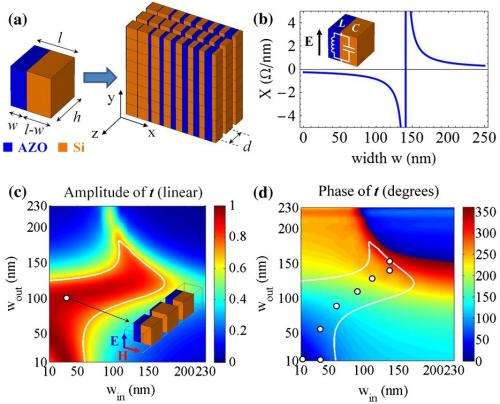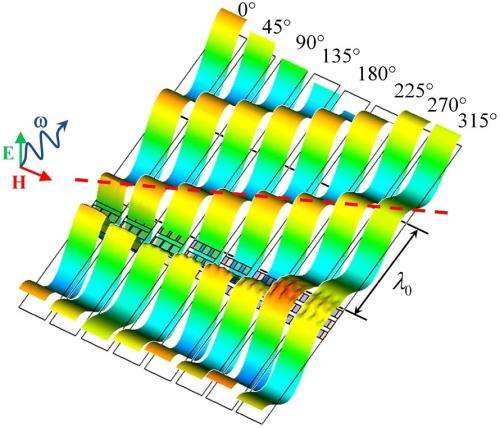May 30, 2013 feature
Meta-transmitarray offers unprecedented control of light on subwavelength scales

(Phys.org) —The ability to guide, bend and focus light at the nanoscale is a highly sought-after goal in the field of nano-optics. Precise and efficient light control has direct applications in solar cells, holography, nanoscale signal processing, CMOS cameras, and many other areas. In a recent study, a team of engineers has proposed a new technique for controlling light at deeply subwavelength scales using a thin stack of patterned surfaces that the engineers call a "meta-transmitarray." The underlying physics of the new concept is very different from any conventional lens and offers greatly improved efficiency and flexibility for manipulating light transmission at the nanoscale.
The researchers, Francesco Monticone, Nasim Mohammadi Estakhri, and Assistant Professor Andrea Alù at The University of Texas at Austin, have published their paper on the meta-transmit-array concept in a recent issue of Physical Review Letters, and their work has been selected as an "Editor's suggestion."
On large scales, light can be controlled in a fairly straightforward way by using conventional dielectric lenses. But since a dielectric lens' properties are dependent on its thickness, these lenses are generally too thick to work well for controlling light at subwavelength scales, preventing their integration into nanophotonic and optoelectronic systems. At radio frequencies, one alternative to dielectric lenses for achieving subwavelength wave control is represented by transmitarrays, which are made of ultrathin sheets called frequency selective surfaces. These surfaces can be locally modeled with circuit concepts, and can shift the phase of incoming waves at will when combined in transmitarrays. So far, transmitarrays have been demonstrated only at radio frequencies.
In the new study, the researchers have integrated the concepts of transmitarrays and metamaterials, or more precisely, metasurfaces, which are the two-dimensional version of metamaterials. While bulk metamaterials are intriguing for their exotic, engineered properties that are not found in nature, they are difficult to fabricate. On the other hand, metasurfaces are planarized versions of metamaterials, with equally intriguing properties, but much easier to fabricate. Previous research has suggested that metasurfaces may be used as planar lenses to extend the concept of frequency selective surfaces beyond radio frequencies to optical frequencies, but the proposed designs had limited efficiency and applicability.

Here, the engineers have first theoretically determined the general conditions to control and mold the transmitted light at will, ensuring at the same time zero reflections and large efficiency. Then, the researchers designed and simulated thin, patterned metasurfaces, realizing meta-transmitarrays that can control light with unprecedented efficiency over subwavelength distances. Each array consists of a symmetric stack of three ultrathin metasurfaces made of building blocks containing two alternating materials: silicon and aluminum-doped zinc oxide. By locally controlling the filling ratio of these two materials in the building blocks, the researchers could design meta-transmitarrays with a wide range of phase patterns. When these patterns are imprinted on the impinging light wave, they can manipulate the wave in one of many ways, such as by bending, focusing, or collimation.
"Recent works have proposed metasurfaces to manipulate wave refraction at the nanoscale," Alù told Phys.org. "First, we proved that designs based on a single surface are inherently limited in efficiency. We then proposed a realistic solution to the problem, showing that with a subwavelength stack of three metasurfaces it is possible to fully control light transmission in amplitude and phase at the nanoscale, with large efficiency and zero reflections. The paradigm we put forward is general, and can be applied to many possibilities for manipulating light, with the important further advantages of being based on CMOS-compatible materials and relative ease of fabrication."
The proposed device also provides good flexibility since its features can be tailored by modifying point-by-point the ratio of the building block materials. The researchers think that these advantages will contribute to making meta-transmitarrays an attractive way to manipulate nanoscale optical transmission for a variety of applications.
"There are many applications out there that can greatly benefit from our findings," Alù said. "The meta-transmitarray idea can have an impact in the many practical scenarios that require an efficient manipulation of the transmitted light with subwavelength resolution and within a planarized, integrated technology. Some relevant examples are holography, photovoltaics, optical tweezers, and imaging. Imagine if we could integrate one of these meta-transmitarrays on top of the CCD of a pocket camera to manipulate the impinging signal pixel by pixel. In addition, our concepts may open and foster new research areas, such as processing optical signals at the nanoscale with subwavelength resolution."
In the future, the researchers plan to work on further bringing these concepts to life.
"We are working full force on seeing how we can bring this concept forward, and in what deep ways we can manipulate the optical signals over subwavelength scales using these concepts," Alù said. "We are also working toward the experimental realization of some of these and related concepts for nanophotonic metamaterials."
More information: Francesco Monticone, et al. "Full Control of Nanoscale Optical Transmission with a Composite Metascreen." PRL 110, 203903 (2013). DOI: 10.1103/PhysRevLett.110.203903
Journal information: Physical Review Letters
© 2013 Phys.org. All rights reserved.




















